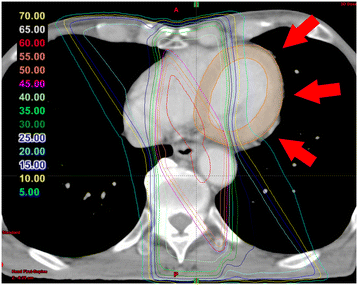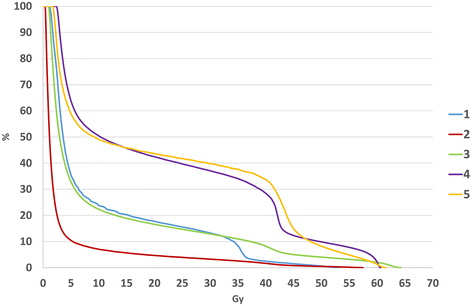Assessment of myocardial metabolic disorder associated with mediastinal radiotherapy for esophageal cancer -a pilot study
- PMID: 25896887
- PMCID: PMC4407329
- DOI: 10.1186/s13014-015-0410-z
Assessment of myocardial metabolic disorder associated with mediastinal radiotherapy for esophageal cancer -a pilot study
Abstract
Background: To evaluate the dose-effect relations for myocardial metabolic disorders after mediastinal radiotherapy (RT) by performing iodine-123 β-methyl-iodophenyl pentadecanoic acid (I-123 BMIPP) scintigraphy.
Methods: Between 2011 and 2012, we performed I-123 BMIPP scintigraphy for patients with esophageal cancer before and six months after curative mediastinal RT. Single photon emission computed tomography (SPECT) images of pre-RT and post-RT were registered into RT dose distributions. The myocardium was contoured, and the regional RT dose was calculated. Normalization is required to compare pre- and post-RT SPECT images because the uptake pattern is changed due to the breathing level. Normalization was applied on the mean of SPECT counts in regions of the myocardium receiving less than 5 Gy. Relative values in each dose region (interval of 5 Gy) were calculated on the basis of this normalization for each patient. The reduction in the percent of relative values was calculated.
Results: Five patients were enrolled in this study. None of the patients had a past history of cardiac disease. The left ventricle was partially involved in RT fields in all patients. The patients received RT with median total doses of 60-66 Gy for the primary tumor and metastatic lymph nodes. Concomitant chemotherapy consisting of cisplatin or nedaplatin and 5-fluorouracil with RT was performed in 4 patients. All patients had reduced uptake corresponding to RT fields. Dose-effect relations for reduced uptake tended to be observed at 6 months after RT with mean decreases of 8.96% in regions at 10-15 Gy, 12.6% in regions at 20-25 Gy, 15.6% in regions at 30-35 Gy, 19.0% in regions at 40-45 Gy and 16.0% in regions at 50-55 Gy.
Conclusions: Dose-effect relations for myocardial metabolic disorders tended to be observed. We may need to make an effort to reduce high-dose mediastinal RT to the myocardium in RT planning.
Figures




Similar articles
-
Evaluation of radiation-induced myocardial damage using iodine-123 β-methyl-iodophenyl pentadecanoic acid scintigraphy.J Radiat Res. 2013 Sep;54(5):880-9. doi: 10.1093/jrr/rrt011. Epub 2013 Feb 14. J Radiat Res. 2013. PMID: 23412468 Free PMC article. Clinical Trial.
-
Association between radiation dose to the heart and myocardial fatty acid metabolic impairment due to chemoradiation-therapy: Prospective study using I-123 BMIPP SPECT/CT.Radiother Oncol. 2016 Apr;119(1):77-83. doi: 10.1016/j.radonc.2016.01.024. Epub 2016 Feb 9. Radiother Oncol. 2016. PMID: 26873792
-
The prevalence of myocardial ischemia after concurrent chemoradiation therapy as detected by gated myocardial perfusion imaging in patients with esophageal cancer.J Nucl Med. 2006 Nov;47(11):1756-62. J Nucl Med. 2006. PMID: 17079807
-
Pharmacokinetics of radioiodinated fatty acid myocardial imaging agents in animal models and human studies.Q J Nucl Med. 1996 Sep;40(3):252-69. Q J Nucl Med. 1996. PMID: 8961803 Review.
-
Implication of microRNAs in the development and potential treatment of radiation-induced heart disease.Can J Physiol Pharmacol. 2017 Oct;95(10):1236-1244. doi: 10.1139/cjpp-2016-0741. Epub 2017 Jul 5. Can J Physiol Pharmacol. 2017. PMID: 28679064 Review.
Cited by
-
Comparison of dosimetric parameters and toxicity in esophageal cancer patients undergoing 3D conformal radiotherapy or VMAT.Strahlenther Onkol. 2016 Oct;192(10):722-9. doi: 10.1007/s00066-016-1020-x. Epub 2016 Jul 14. Strahlenther Onkol. 2016. PMID: 27418129 Clinical Trial. English.
-
Evidence for a cardiac metabolic switch in patients with Hodgkin's lymphoma.ESC Heart Fail. 2019 Aug;6(4):824-829. doi: 10.1002/ehf2.12475. Epub 2019 Jul 6. ESC Heart Fail. 2019. PMID: 31278857 Free PMC article.
-
Nuclear medicine imaging methods of early radiation-induced cardiotoxicity: a ten-year systematic review.Front Oncol. 2023 Oct 9;13:1240889. doi: 10.3389/fonc.2023.1240889. eCollection 2023. Front Oncol. 2023. PMID: 37876964 Free PMC article.
-
Dose-Dependent Radiation-Induced Myocardial Damage in Esophageal Cancer Treated With Chemoradiotherapy: A Prospective Cardiac Magnetic Resonance Imaging Study.Adv Radiat Oncol. 2020 Aug 5;5(6):1170-1178. doi: 10.1016/j.adro.2020.07.012. eCollection 2020 Nov-Dec. Adv Radiat Oncol. 2020. PMID: 33305078 Free PMC article.
-
The Impact of Cardiac Radiation Dosimetry on Survival After Radiation Therapy for Non-Small Cell Lung Cancer.Int J Radiat Oncol Biol Phys. 2017 Sep 1;99(1):51-60. doi: 10.1016/j.ijrobp.2017.04.026. Epub 2017 Apr 27. Int J Radiat Oncol Biol Phys. 2017. PMID: 28816160 Free PMC article.
References
-
- Schellong G, Riepenhausen M, Bruch C, Kotthoff S, Vogt J, Bolling T, et al. Late valvular and other cardiac diseases after different doses of mediastinal radiotherapy for Hodgkin disease in children and adolescents: report from the longitudinal GPOH follow-up project of the German-Austrian DAL-HD studies. Pediatr Blood Cancer. 2010;55(6):1145–52. doi: 10.1002/pbc.22664. - DOI - PubMed
MeSH terms
Substances
LinkOut - more resources
Full Text Sources
Other Literature Sources
Medical
Miscellaneous

